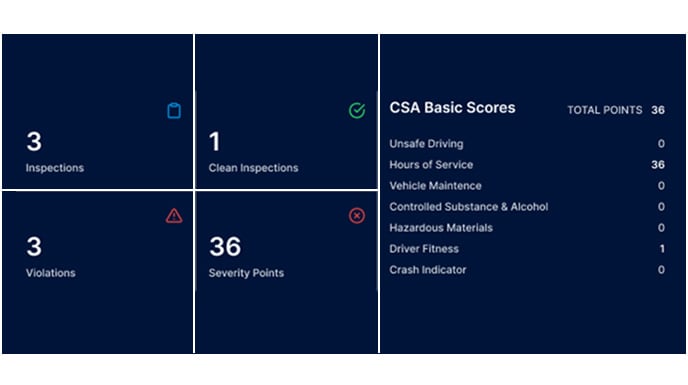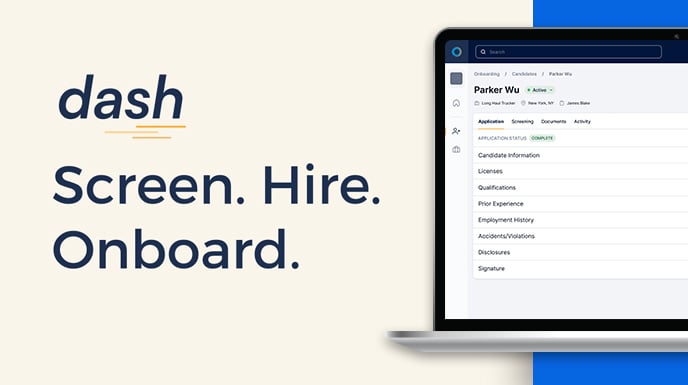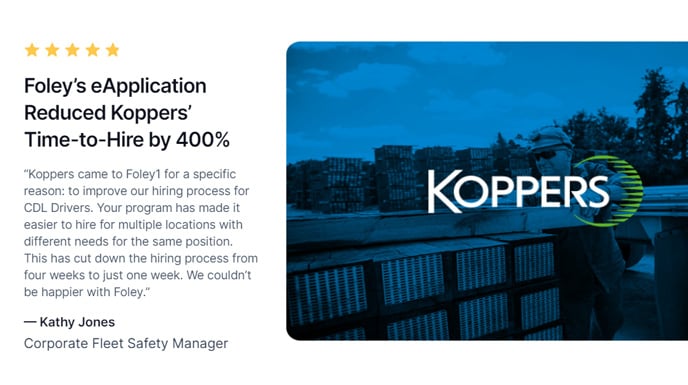Compliance Review: FMCSA Hours-of-Service Rules

Think you know the FMCSA HOS regulations? Brush up on them and some exclusions, like the 16-hour exemption, so you can operate a safe fleet.
The FMCSA hours-of-service (HOS) rules are designed to help drivers operate commercial motor vehicles (CMVs) safely by avoiding excessive fatigue. They regulate how long employees can drive, when they need to take off, and how long they need to rest.
Who do the HOS rules apply to?
HOS regulations must be followed by anyone who operates a commercial vehicle in the US. A vehicle is a CMV if it meets one of any of the following criteria:
- Weighs over 10,000 pounds with or without a load
- Transports hazardous materials (Hazmat) requiring a placard
- Transport 16 or more people, including the driver
- Transports nine or more people, including the driver, for compensation
Now that you know what’s considered a CMV, let’s go over these HOS regulations:
- DOT 14-hour rule
- 11-hour rule
- 60/70-hour limit rule
- 34-hour restart rule
- 30-minute break rule
- Split sleeper berth rule
Overview of FMCSA Hours of Service Rules
CDL 14-Hour Rule
Following a minimum 10-hour break, employees cannot drive more than 14 consecutive hours. Regardless of other tasks they may do that don’t involve driving, once 14 hours have passed since their last 10-hour break, they are not permitted to drive until another 10 hours of off-duty time has passed.
11-Hour Driving Limit
Within that 14-hour shift limit, employees cannot drive for more than a total of 11 hours. These hours do not have to be consecutive but are rather a combination of all the hours spent driving. Once these 11 hours are hit, drivers must take a 10-hour break.
60/70-Hour Weekly Limit
Drivers also have limitations on how many hours they can drive on a weekly basis.
If your drivers don’t operate daily, they can no longer drive CMVs once they have worked 60 hours of on-duty time within seven days. If your drivers do operate daily, they can no longer drive CMVs after they have worked 70 hours of on-duty time within eight days.
This weekly limitation resets after a 34-hour restart, which is explained below.
34-Hour Restart
Once your drivers hit the 60 or 70-hour weekly limit, they must take 34 consecutive hours of off-duty time. This time allows your drivers to get the much-needed rest they need after working so many hours. Once the 34 hours have passed, they are free to drive up until the 60 or 70-hour weekly limits explained above.
One of the best 34-hour restart examples is to think of it as a "reset button" for their workweek. If a driver is expected to exceed 60 hours of on-duty time in seven days or 70 hours of on-duty time in eight days, the driver can "break" this streak by taking 34 consecutive hours off. The 34-hour reset can be taken in the sleeper berth or during off-duty time.
30-Minute Rest Breaks
As soon as your employees have driven for eight hours, they need to take a 30-minute break. They don’t have to be off duty during the break, but they can’t drive their CMVs until after the 30 minutes have passed. Think of the DOT hours of service 30-minute break like any other employee's workday break.
Split Sleeper Berth Rule
There is some confusion surrounding this rule, but it’s designed to give your drivers more flexibility when it comes to their off-duty periods. Simply put, your drivers can split their 10-hour off-duty time one of two ways: 8/2 or 7/3.
- The 8/2 split allows drivers to spend 8-10 hours in the sleeper berth, and then 2-8 hours doing whatever they please, but they must stay off-duty.
- The 7/3 split allows drivers to spend as little as seven hours in the sleeper berth, and the other portion of their off-duty time must be a minimum of three hours long.
The two splits can be taken in any order and must add up to at least 10 hours; however, the split sleeper berth is not considered a full 10-hour reset – it only moves the starting time of the 14-hour driving window. When your drivers finish the second rest shift, the 14-hour clock restarts from the end of the first rest shift.
150 Air Mile Exemption
There are also exclusions to these rules, and one of them is the 150 air-mile exemption. Prior to September 2020, this was known as the 100-air-mile exemption and required a 100-air-mile radius log book.
Short-haul CDL drivers can do the following when using the exemption:
- Stay within a 150-mile-radius of their starting point
- Work for only 14 consecutive hours
- Take a 30-minute break after 8 hours of driving time if they will continue to operate a CMV
- Stay on duty (but not driving) for their breaks
Need more information on the 150-air-mile exemption? Read this related Foley article: Hours of Service: Reviewing Changes to the 100-Air-Mile Exemption
16-hour Exception
Another exclusion is the DOT 16-hour rule, which allows short-haul drivers to extend their 14-hour driving period by two additional hours once per week. It doesn’t extend their 11-hour daily driving limit, but it does give them up to 16 hours to accommodate long loading or unloading periods or complete other tasks that don't involve driving a CMV.
Want to know more about the 16-hour exception? Read this related Foley article: Understanding the 16-Hour Short Haul Exemption
Stay on Track with Hours-of-Service Regulations
The easiest way to follow these HOS rules is to have an electronic logging device (ELD) in all your trucks.
Remember, if your drivers are pulled over for a roadside inspection, officials will likely check their hours-of-service documents to ensure they're operating compliantly.
We know there are a lot of regulations to follow with just FMCSA hours of service alone, so if you’re feeling unsure about any of your other DOT compliance requirements, let the experts at Foley help.
You can get a free, no-obligation demo of our DOT compliance platform now and never worry about complying with HOS rules or passing a DOT audit again. Fill out the form below!
Related Articles
DOT Hours of Service: Reviewing Changes to the 100-Air-Mile Exemption
A Review of Driver Qualification Files for Bus Drivers
New Clearinghouse Rule Now in Effect: What it Means for Your Drivers
.png)


